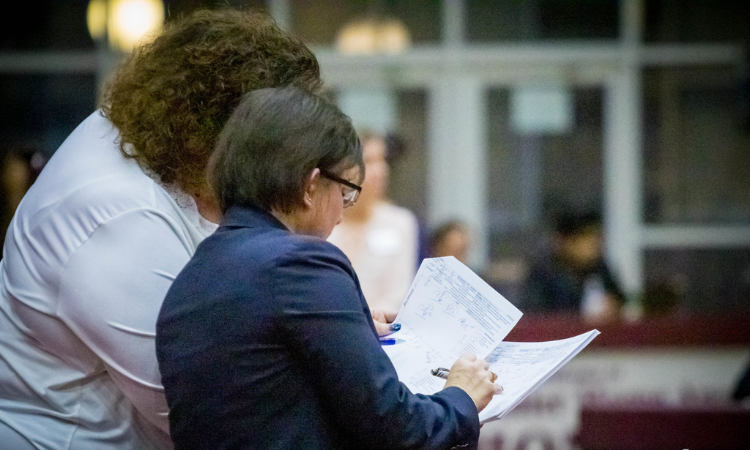Longtime gymnastics fans will remember a time when elite gymnasts had to compete both compulsory and optional routines. In the compulsory routines, each athlete had to complete the exact same routine and elements and were judged against a perfect, ideal standard.
Obviously, we don’t have compulsory competitions in NCAA gymnastics. However, the Yurchenko full is as close as we get to one. So much so that the NCAA devalued it from a 10.000 (its value in level 10) to a 9.950 to incentivize gymnasts to perform a wider variety of vaults and more difficulty. With so many Yurchenko fulls to judge, you would think that NCAA judges would have no problem evaluating them consistently, right?
To find out the answer, I judged 50 Yurchenko fulls from 15 different teams from Week 3’s competitions to try to see the consistency of judging this vault across the country. Generally, scores were higher than what they could have been based on the deductions that I saw. However, as always, we have to leave grace for the lack of instant replay, slow motion, and the limited view these judging panels have.
The most common deductions I saw were flexed feet, a closed shoulder angle on the table, bent arms, leg separations, and an early piking of the hips before the landing. The most common landing errors were steps, hops, and gymnasts landing with their chest down or forward. Also, remember that if an athlete steps toward the vault when they land their full twist, it’s an additional flat tenth deduction for under rotation. Finally, all of these vaults have a maximum score of a 9.950, so it’s impossible to get a 10.0 on a Yurchenko full.
To show you an example of the variety of judging opinions I found from Week 3, I’ll show you a comparison of three sets of two or three vaults that have similar deductions yet are scored differently. Some vaults received the same score but may seem vastly different in quality. After reading this article, hopefully you’ll have your own opinion on whether or not the scoring is consistent, and at the very least you’ll have a better eye for judging this vault from your couch or the stands.
Exemplary Yurchenko Fulls
These vaults have everything you look in a great vault: speed, power, repulsion off the table, dynamics, and a controlled, safe landing. Both athletes below have great form on the table and in the air, with just minor landing deductions.
Naya Howard (Georgia) – 9.900 (9.900/9.900)
Howard hops on her landing (-0.050 to -0.100), and also has a slight break in her hips at the end.
My Score: 9.850
Elexis Edwards (Ohio State) – 9.850 (9.850/9.850)
These vaults are almost identical. Edwards has a hop on the landing (-0.050 to -0.100) as well and maybe a bit of a break in her hips right at the end.
My Score: 9.850
Under-Rotated Yurchenko Fulls
Two of these vaults had the same score as well as the same issues; both were under-rotated, piked down, and had a step forward. The third vault is also under-rotated but scored significantly higher.
Ella Cesario (California) – 9.575 (9.500/9.650)
Cesario bends her arms slightly on the table (-0.050) and pikes down pretty aggressively after she finishes the twist (-0.100). Her chest is down on her landing (-0.050), and she hops forward (-0.100) due to the vault’s under-rotation (-0.100).
My Score: 9.500
Sydney Kho (Boise State) – 9.575 (9.550/9.600)
Kho has a slight shoulder angle (-0.050) and arm bend on table (-0.050). She’s pretty clean in the air but pikes down (-0.050, not as severe as Cesario), has her chest slightly forward on her landing (-0.050), steps forward (-0.050 to -0.100), and under-rotates (-0.100). Her direction is also off slightly to the left throughout the entire vault (-0.050).
My Score: 9.550
Katie Finnegan (Georgia) – 9.775 (9.700/9.850)
Finnegan does a great job trying to pull off the “college stick” and may have even fooled judge No. 2 given her 9.850 score for this vault. But you can see from her landing with her chest down (-0.050) that she under-rotated (-0.100) and had to take a step forward to regain control of her landing (-0.100). Compared to the other two vaults, this is much cleaner on the table, and she keeps her body straight through to the landing position. I do think this should have scored higher than the other two vaults above, but not a 9.775, especially since with the step forward, her maximum score should be a 9.750.
My Score: 9.700
Lower-Scoring Yurchenko Fulls
The first two vaults are from the same competition (aka they had the same judging panel), and both had some significant form issues, as well as large pike downs and a large step on the landing. As a judge, it gets harder to accurately score vaults that have a lot of different deductions. Judges only get one look at the vault, and sometimes it can be challenging to get everything down on paper before their memory starts to fail.
When I was learning to judge vault, I was taught to give it an overall grade (A-, C+, etc.), and to keep that overall impression in mind to be sure that the more poorly executed vaults received scores more consistent with their “grade.” Theoretically, this helps prevent you from overscoring vaults with several deductions. Let’s see how they did.
Aimee Titche (Yale) – 9.550 (9.650/9.450)
Titche had quite a few different deductions on this vault. She has some noticeable leg separation on the table (-0.050), bent arms (-0.100), flexed feet (-0.100), and a 90-plus degree pike down on her landing (-0.200 to -0.250). On her landing, her chest remains low (-0.100), she takes a large step back (-0.200), and she has a bit of a direction error off to her left (-0.050).
My Score: 9.150
Gillian Cummins (UW-Stout) 9.725 (9.800/9.650)
This vault is a little cleaner than Titche’s but still has some obvious execution errors. Cummins’ legs are separated onto the table (-0.050) and on the table (-0.050), and she has some pretty bent arms as well (-0.100). In the air her feet are flexed (-0.100), her knees are loose (-0.050), and she pikes down (-0.100). Her chest is a little forward on her landing (-0.050), and she takes a large step backward (-0.200)
My score: 9.250
Mia Davis (Towson) – 9.725 (9.700/9.750)
Davis’ vault is more similar to the vaults in the first group (the Exemplary Yurchenko Fulls), with the exception of the large hop backward on her landing. She has great form throughout, good height and great distance. For deductions, she has a slight arm bend on the table (-0.050) and a large hop backward (-0.200). Interestingly, this vault scored the same as Gillian Cummins above.
My score: 9.700
These vaults were chosen to show some of the typical categories of execution errors that judges often see and generally how they should score, regardless of what conference, athlete, judge, or competition is part of the equation. Well-executed vaults make the gymnastics look easy, whereas the ones that struggle help us appreciate how difficult this sport can be. Every judge I’ve ever worked with always wants the athlete to succeed, but judges also have the difficult job of separating the good from the great—and doing so consistently. Not only do they have to be consistent within themselves, but they also have to be consistent as a group so that every judge is interchangeable and coaches and athletes can expect the same quality every weekend.
Underscoring rarely happens in NCAA gymnastics, but overscoring has its dark side. It happens at meets across the country, not just the ones that are televised or that feature high-ranking teams or famous athletes. I would argue that overscoring actually helps athletes with poorer execution even more than those getting 10.0s when maybe it was only a 9.900.
Yes, high scores, program records and individual records are all exciting, and we all want to see these athletes succeed. Judges usually do a pretty good job of appropriately ranking the athletes they see, and generally the best vault in that specific competition will receive the best score. However, when we have dozens of teams competing across the country, ranking athletes appropriately is not enough.
What I wish the majority of judges would realize is that it’s OK to give an NCAA gymnast a score below a 9.500, even if they didn’t fall. It’s important to score these routines accurately so coaches can make the correct decisions when deciding lineups, gymnasts can continue to improve their technique and execution, and the athletes that are able to do gymnastics with near-perfect execution are rewarded as such.
The solution to some athletes being overscored is not to overscore all athletes. The solution is to provide consistent and accurate judging each and every weekend, regardless of who sits in the chair.
READ THIS NEXT: Judge’s Inquiry: Breaking Down a Week 3 Routine on Each Event
Article by Rhiannon Franck
Rhiannon Franck is a former national-rated NAWGJ women’s gymnastics judge with over 15 years of USAG judging experience and nine seasons judging NCAA gymnastics. Outside of gymnastics, Franck works at a university as a nursing professor and loves to travel.
Like what you see? Consider donating to support our efforts throughout the year!





I feel putting up school and athlete’s names in this article was unnecessary. It is easy to evaluate a performance from angle of camera and in slow motion. Not only did you compare division one athletes to division 3 athletes but criticized the evaluation of many seasoned collegiate judges who were actually present on each side of the routine! Your score more accurate than probably 50 other on site judges?
It stands to reason that she does score more accurate than the 50 other on site judges, not because of her experience, but because she has time to watch these vaults with no time pressure and possibility to repeat.
But this isn’t to the point. The point is that gymnastics is a judged sport. It’s the needles eye that every meet gets threaded through. It is absolutely okay to put names and schools in this article. They competed to be judged, they are getting judged. Nothing in this article is doing more than naming the deductions that were present and are there for your eyes to see! This isn’t criticizing Mia Davis for “always doing this” or Gillian Cummis for “ugly form” or anything of the kind. They are not getting judged on personality, but on their performance of the day.
Furthermore, I find it very, very helpful that Div III Performances are judged! It helps me train my eye for those situations where there are a couple of deductions to take at once. I can see how judging gets a lot more complex and I appreciate those judges a ton.
But it also sheds a light on the problem of overscoring not just in an annual LSU vs Florida meet where you might question a couple of 9.95/10.00 splits. I completely agree: It’s the “floor” of the scoring, not the ceiling that is the main problem. A lot of 9.85s look a lot more questionable to me than 10.00…